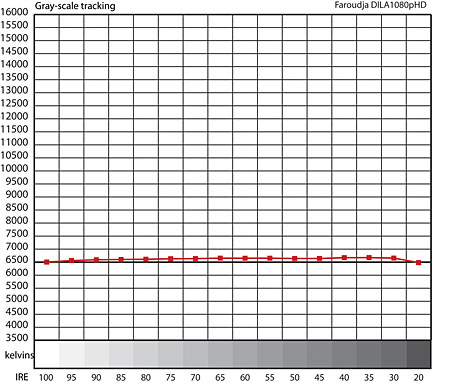Faroudja DILA1080pHD and DVP1080 D-ILA Video Projector and HD Digital Video Processor Testing

On multiburst patterns from my AccuPel HDG-3000 HD test pattern generator, in either component or DVI, the 480i luminance response extended out to the highest frequency burst: 6.75MHz. At 720p, luminance appeared to be down slightly in the maximum 37.1MHz multiburst, but the lines in the burst pattern were still visible. And at 1080i (in High Bandwidth mode) the lines in the 37.1MHz multiburst were clearly resolved. A similar result was obtained from component. And in all cases the color bandwidth, while it began rolling off markedly at about half the luminance bandwidth, was more than wide enough for consumer source material.
I won't bore you here with a discussion of the quality of the de-interlacing in the DVP1080. It's a Faroudja, so you know you'll have to look hard and deep before you see any artifacts, and then you're probably imagining them. The processor will accept a 480i DVI input, so you can make full use of the Faroudja's capabilities with a DVD source, provided the DVD player is one of the few that will provide 480i through its digital video output.
Viewing the clean horizontal and vertical lines generated by the AccuPel's for its Sharpness pattern, 1080i showed no sign of enhancement or ringing. There was a trace of ringing visible in 720p, however, and a bit more in 480i, even with the Detail control turned down to zero.
With about 200 hours on the projector, I measured a peak contrast of 1905:1 (20.95 foot-Lamberts peak white on a 100% full-screen white field, 0.011fL video black) on my 78-inch-wide Stewart Studiotek 130 screen. The contrast was virtually the same on the Screen Research screen, but the peak white and black levels dropped to 13.07fL and 0.007fL, respectively (with an 80-inch wide image). But the Faroudja's pseudo ANSI contrast (measured on the first sample of the projector) was a low 73:1. ANSI (checkerboard) contrast is notoriously difficult to measure accurately, so I can only offer a comparison. Measured at the same time, under the same conditions on the Screen Research screen, a Yamaha DPX-1200 measured 2260:1 peak and 259 pseudo ANSI. Nevertheless, while the Yamaha's deep blacks and shadow detail were visibly superior to the Faroudja's, the difference was far more subtle than the pseudo ANSI numbers might suggest. (These "ANSI" measurements were made on 8 of the 16 squares in the checkerboard test pattern—the middle two columns—thus my use of the term pseudo ANSI.)
The color points were no more accurate than we have measured on other digital projectors: red was good, green far deeper into green than either the NTSC or high definition standard, and blue also richer than either standard. While a wider color gamut than the standard calls for might appear to be desirable, in fact all sources were (or should have been) produced to the standard so should be played back that way. (Most sources—even HD—are still produced in reference to NTSC standard phosphor colors.) But apart from too vibrant greens (endemic nearly across the board to digital displays) the colors on the screen looked pleasing and natural.
The color temperature measurements are shown in the chart. Since the projector had been pre-calibrated, I measured and reviewed it as it came out of the box; there are no "before" readings. The numbers here are good. The color temperature is just a trace blue, and the x,y coordinates—not shown—were a little minus green (closer to x=0.311, y=0.323 than the D65 point of x=0.313, y=0.329) as measured on our Photo Research PR-650 spectroradiometer.























































